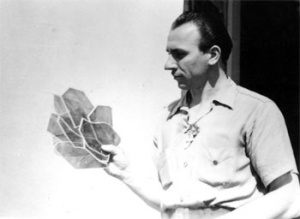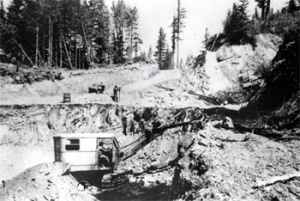Personal tools
Help
Tools
Class Notes
- Do you have news for fellow WSU alumni and other readers of Washington State Magazine? Send us your class note.
Our Story
written by alumni, faculty and friends.
NOTE: THIS IS A LEGACY SITE AND IS NOT REGULARLY MAINTAINED
Views
Geology Field Trip
From Our Story
by Jean Gleason Witt, class of ’43
In early November 1942, the geology class I was taking was supposed to go on a field trip. Gas rationing was immanent because of the war, so we vowed that we would go, rain or shine. Of course, it rained, but everyone showed up on schedule, except the boy from California.
I was the only girl in the class, a botany major among the geologists and mining engineers. There were so few of us that we could all fit into two cars. A couple of the boys had roped their room mates into providing the cars and doing the driving. We went over into Idaho, to see the muscovite mica mines.Near Troy we climbed over a barbed wire fence into a pasture to examine the local bedrock. Horses in an adjacent field trotted over to get a better look at us.
We then drove down to Deary, where Mr. Tier, our instructor (who may have been a graduate student studying for his Ph.D.), went into a store to make inquiries, while towns-men lounging out front regarded our soggy group with considerable curiosity. On the advice he obtained we drove out into the hills a few miles, and left the cars. We were afraid they would get stuck in the mud on the un-surfaced road. The mica mine was supposed to be three miles up the mountain, but it turned out to be nearer four. We slogged along through the mud and rain for most of the morning. Eventually we located the mine near the top of the mountain—a very small prospect hole, running about two or three hundred feet into the mountainside. It was not in operation at the moment—shut down for the winter perhaps.
The boys lighted a torch and we went in. The passage was so narrow that we could touch both sides with our hands, but not tall enough to allow us to stand up straight. The first man held the torch; we took hold of the backs of each other’s coats, in a line, and followed him in, heads ducked. The tunnel opened out into a small room. Here miners had been digging out ser cite, a low-grade white powdery form of mica—of use only because the war had increased the need for electrical insulation. The boys lit another torch so we could get a good look at the room, which was taller than wide and extended perhaps 20 feet over our heads—stoped, as they said.
This was not the mine our instructor was looking for, so we went back out again to see if we could find it. It was evidently further away than we had been led to believe. After a futile search we decided we would have to be content with the present one. We went back in again, this time without using the torches in the tunnel. I was second in line. The rest were all clutching each other’s coats behind me—but I had lost my hold on the boy ahead of me. He said to me, being funny in the dark,
“Jean, is that your cold clammy hand on the back of my neck?”
I wasn’t within six feet of him. I replied, “Well, if it’s cold and clammy it’s mine.”
Once we were back in the mine proper they lighted the torches so we could look at the diggings a little more. We picked up samples of the damp sercite, squeezing it together into lumps. (I still have mine!) I was not the only one who had never been in a mine before.
The rain was coming down hard as we started back to the cars; there was even a little snow on the ground. Soon my wool mackinaw was soaked, water was dripping off the tail of my head-scarf, and my swept-up hair was drooping down over my face.
The rest of us went into the drugstore and stood around its big heating stove to dry out. The drugstore clerk was a high school girl, and the boys went over to make her acquaintance. If ever I saw a pack of wolves on the howl! It was simply hilarious. The girl did her best to look sophisticated by smoking one cigarette after another, as fast as she could. When she had to go wait on a customer the boys shifted their attention to her little brother (perhaps 12 years old,) who was also chain smoking. They found out her name, and that she didn’t have a date for the dance that night. Then they really poured it on thick, saying they’d come back and take her to the dance. Of course, she didn’t really fall for it. All the time she kept looking at me, as if wondering what I was doing with such a bunch of wolves.
When we were back in the car the boys asked me if I thought she was good looking, how old she might be, etc., etc., and they commented unfavorably on her smoking so many cigarettes.
Hiking eight miles in the rain had not dampened our spirits in the least. We all felt we had had a wonderful time, even if we didn’t find the beryl mine.
On Monday morning, as we sat around waiting for the class to begin, we talked about what a great time we had had on the field trip. I can still see the incredulous look on the face of the boy from California: “You mean you went?” When he had waked up to rain on Saturday, he’d taken one look, and gone back to sleep, thinking the trip would be canceled.
Our Story site map
Our Story main page | Our Story categories | Help Desk
Contact | Give | Advertise
Washington State Magazine | Washington State University | Class Notes
Our Story is coordinated by
In partnership with
Our Story and Washington State Magazine are publications of Washington State University. All rights reserved.
P.O. Box 641227, Washington State University, Pullman, WA 99164-1227 USA | wsm@wsu.edu, 509-335-2388
Accessibility | Copyright | Policies


